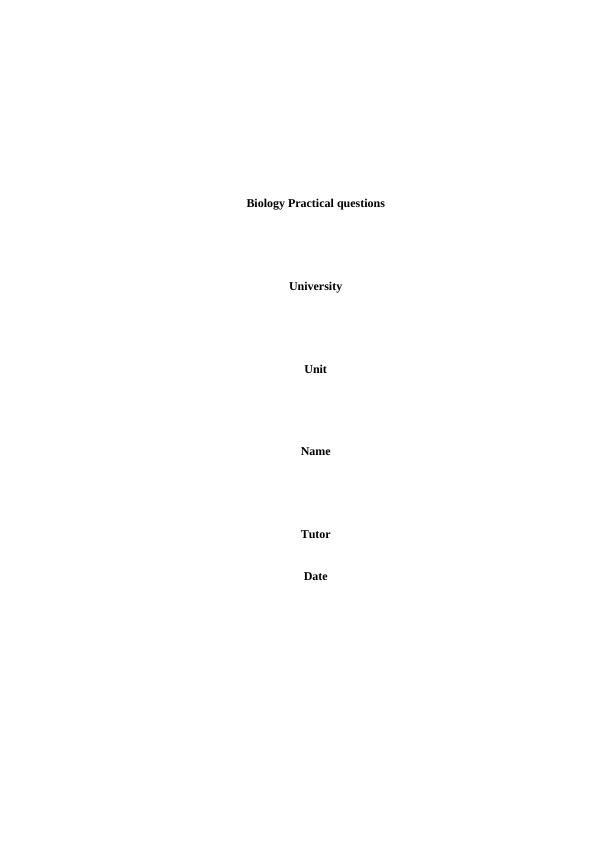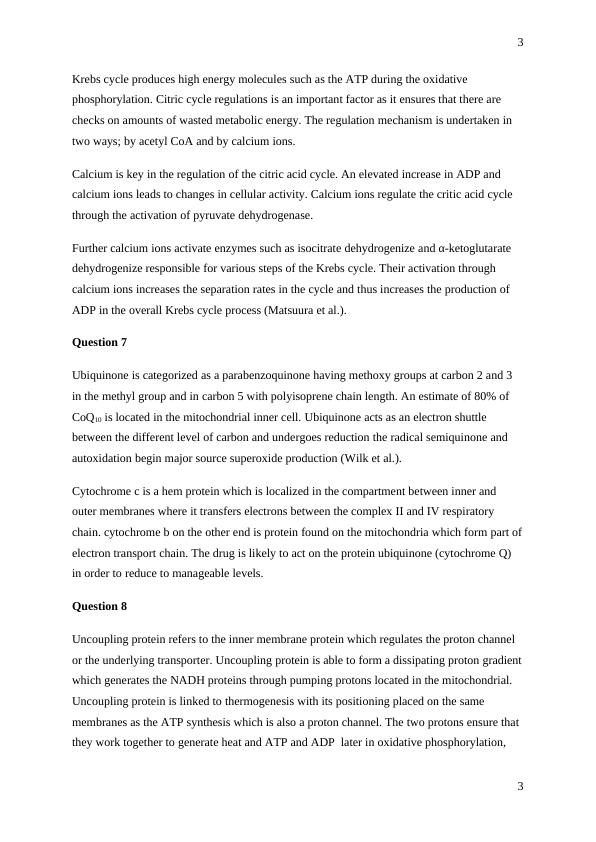Biology Practical Questions
Added on 2023-04-12
7 Pages1601 Words268 Views
Biology Practical questions
University
Unit
Name
Tutor
Date
University
Unit
Name
Tutor
Date

2
Question 1
Krebs cycle refers to a series of chemical reactions which provide energy in form of ATP
occurring in the mitochondria. It provides hydrogen and electrons necessary for electron
transport chain. Calcium plays a fundamental role in cellular signalling. It acts on the signal
transduction which results in the activation of ion channels. The mitochondrial calcium
elevates the rate of oxygen intake due to the activation of calcium-activated dehydrogenize
enzyme, and through activation of mitochondrial nitric oxide (Paupe, and Prudent).
Mitochondrion target site of the agonist of Calcium ions signals the organelle modeling
function through direct measurement of the mitochondrion and cytosolic ATP levels. In HeLa
cells and cultures of skeletal myotubules, there is an occurrence of agonist stimulation on
cytosolic and mitochondrial which cases rise in calcium ions thus causing an increase in
ATP. Further increase in calcium ions leads to induced long-lasting agonist washout causing
a significant increase in ATP and overall function of the Krebs cycle. This indicates a direct
role of mitochondrial calcium ions during the Krebs cycle in increasing the production of
ATP (Contreras et al.).
Question 2
ATP is the primary source of high energy phosphate bonds in the cell and acts as allosteric
effects or in numerous cell functions. The intracellular ATP is obtained from the cytosolic
glycolysis and the process of mitochondrial oxidative phosphorylation. The mitochondrial
efflux is linked to the exchange function of the Na+–Ca2+–Li+. Calcium efflux in the
mitochondrial is depended (Santo-Domingo, and Demaurex)
The concentration gradient in the cytosol often diffuses rapidly within its compartment.
Calcium sparks in the cytosolic tend to be produced in a shorter time around the calcium
change, thus making the cytosol to have less intracellular calcium.
There is a higher quantity of calcium ions in the mitochondrial matrix which is key in cellular
function. These flux influents play a key role in the production of energy and initiate cell
death. Thus compared to the cytosol, calcium quantities are high in the mitochondrial matrix
(Mammucari et al.).
Question 3
2
Question 1
Krebs cycle refers to a series of chemical reactions which provide energy in form of ATP
occurring in the mitochondria. It provides hydrogen and electrons necessary for electron
transport chain. Calcium plays a fundamental role in cellular signalling. It acts on the signal
transduction which results in the activation of ion channels. The mitochondrial calcium
elevates the rate of oxygen intake due to the activation of calcium-activated dehydrogenize
enzyme, and through activation of mitochondrial nitric oxide (Paupe, and Prudent).
Mitochondrion target site of the agonist of Calcium ions signals the organelle modeling
function through direct measurement of the mitochondrion and cytosolic ATP levels. In HeLa
cells and cultures of skeletal myotubules, there is an occurrence of agonist stimulation on
cytosolic and mitochondrial which cases rise in calcium ions thus causing an increase in
ATP. Further increase in calcium ions leads to induced long-lasting agonist washout causing
a significant increase in ATP and overall function of the Krebs cycle. This indicates a direct
role of mitochondrial calcium ions during the Krebs cycle in increasing the production of
ATP (Contreras et al.).
Question 2
ATP is the primary source of high energy phosphate bonds in the cell and acts as allosteric
effects or in numerous cell functions. The intracellular ATP is obtained from the cytosolic
glycolysis and the process of mitochondrial oxidative phosphorylation. The mitochondrial
efflux is linked to the exchange function of the Na+–Ca2+–Li+. Calcium efflux in the
mitochondrial is depended (Santo-Domingo, and Demaurex)
The concentration gradient in the cytosol often diffuses rapidly within its compartment.
Calcium sparks in the cytosolic tend to be produced in a shorter time around the calcium
change, thus making the cytosol to have less intracellular calcium.
There is a higher quantity of calcium ions in the mitochondrial matrix which is key in cellular
function. These flux influents play a key role in the production of energy and initiate cell
death. Thus compared to the cytosol, calcium quantities are high in the mitochondrial matrix
(Mammucari et al.).
Question 3
2

3
Krebs cycle produces high energy molecules such as the ATP during the oxidative
phosphorylation. Citric cycle regulations is an important factor as it ensures that there are
checks on amounts of wasted metabolic energy. The regulation mechanism is undertaken in
two ways; by acetyl CoA and by calcium ions.
Calcium is key in the regulation of the citric acid cycle. An elevated increase in ADP and
calcium ions leads to changes in cellular activity. Calcium ions regulate the critic acid cycle
through the activation of pyruvate dehydrogenase.
Further calcium ions activate enzymes such as isocitrate dehydrogenize and α-ketoglutarate
dehydrogenize responsible for various steps of the Krebs cycle. Their activation through
calcium ions increases the separation rates in the cycle and thus increases the production of
ADP in the overall Krebs cycle process (Matsuura et al.).
Question 7
Ubiquinone is categorized as a parabenzoquinone having methoxy groups at carbon 2 and 3
in the methyl group and in carbon 5 with polyisoprene chain length. An estimate of 80% of
CoQ10 is located in the mitochondrial inner cell. Ubiquinone acts as an electron shuttle
between the different level of carbon and undergoes reduction the radical semiquinone and
autoxidation begin major source superoxide production (Wilk et al.).
Cytochrome c is a hem protein which is localized in the compartment between inner and
outer membranes where it transfers electrons between the complex II and IV respiratory
chain. cytochrome b on the other end is protein found on the mitochondria which form part of
electron transport chain. The drug is likely to act on the protein ubiquinone (cytochrome Q)
in order to reduce to manageable levels.
Question 8
Uncoupling protein refers to the inner membrane protein which regulates the proton channel
or the underlying transporter. Uncoupling protein is able to form a dissipating proton gradient
which generates the NADH proteins through pumping protons located in the mitochondrial.
Uncoupling protein is linked to thermogenesis with its positioning placed on the same
membranes as the ATP synthesis which is also a proton channel. The two protons ensure that
they work together to generate heat and ATP and ADP later in oxidative phosphorylation,
3
Krebs cycle produces high energy molecules such as the ATP during the oxidative
phosphorylation. Citric cycle regulations is an important factor as it ensures that there are
checks on amounts of wasted metabolic energy. The regulation mechanism is undertaken in
two ways; by acetyl CoA and by calcium ions.
Calcium is key in the regulation of the citric acid cycle. An elevated increase in ADP and
calcium ions leads to changes in cellular activity. Calcium ions regulate the critic acid cycle
through the activation of pyruvate dehydrogenase.
Further calcium ions activate enzymes such as isocitrate dehydrogenize and α-ketoglutarate
dehydrogenize responsible for various steps of the Krebs cycle. Their activation through
calcium ions increases the separation rates in the cycle and thus increases the production of
ADP in the overall Krebs cycle process (Matsuura et al.).
Question 7
Ubiquinone is categorized as a parabenzoquinone having methoxy groups at carbon 2 and 3
in the methyl group and in carbon 5 with polyisoprene chain length. An estimate of 80% of
CoQ10 is located in the mitochondrial inner cell. Ubiquinone acts as an electron shuttle
between the different level of carbon and undergoes reduction the radical semiquinone and
autoxidation begin major source superoxide production (Wilk et al.).
Cytochrome c is a hem protein which is localized in the compartment between inner and
outer membranes where it transfers electrons between the complex II and IV respiratory
chain. cytochrome b on the other end is protein found on the mitochondria which form part of
electron transport chain. The drug is likely to act on the protein ubiquinone (cytochrome Q)
in order to reduce to manageable levels.
Question 8
Uncoupling protein refers to the inner membrane protein which regulates the proton channel
or the underlying transporter. Uncoupling protein is able to form a dissipating proton gradient
which generates the NADH proteins through pumping protons located in the mitochondrial.
Uncoupling protein is linked to thermogenesis with its positioning placed on the same
membranes as the ATP synthesis which is also a proton channel. The two protons ensure that
they work together to generate heat and ATP and ADP later in oxidative phosphorylation,
3

End of preview
Want to access all the pages? Upload your documents or become a member.
Related Documents
The glucose molecule is catabolised into waterlg...
|6
|1348
|26
Cellular Metabolism Assignmentlg...
|18
|2315
|493
Chemistry and Biochemistry – BIOB111lg...
|11
|1544
|260
Exercise Physiology Assignmentlg...
|6
|1798
|98
Process of Energy Production by Aerobic Respirationlg...
|10
|1727
|293
Assign. 1: Question 1 Surname, First Name. a).Glucose mlg...
|4
|2931
|28